Abstract
The severely burned patient responds differently to starvation ketosis in the early stage of injury as compared to the normal individual. A similar response has been observed in the patient after skeletal trauma and sepsis. In order to determine the extent of muscle protein contribution and the mechanism(s) involved, 11 burn patients with 35% to 80% BSA burn were resuscitated using carbohydrate-free solutions for 3 days followed by unrestricted intake. Blood was drawn daily and 24-hour urinary nitrogens were determined. Controls consisted of 10 preoperative elective surgical patients and two normal volunteers. The burned patients lost a mean +/- SEM of 17.1 +/- 1.72 g nitrogen per day on the third day. The mean +/- SEM ketone body response on the third day for burned patients was 385 +/- 77 mumol/l compared to 727 +/- 81 mumol/l for control patients. The mean +/- SEM 3-methylhistidine loss for burned patients on the third day was 9.83 +/- 0.82 mumol/kg compared to 3.6 mol/kg for control patients. Insulin levels on the third day of fast were three times the normal group. This insulin increase may be the modulating factor that suppresses excessive fat mobilization. This metabolic response causes a lower plasma ketone level, which may then necessitate the need for continued protein catabolism for glucose production for certain tissues. The protein contribution to the hypercatabolic response as assessed by increased urinary nitrogen losses is in part supported by an increased muscle protein breakdown as indicated by increased 3-methylhistidine excretion.
Full text
PDF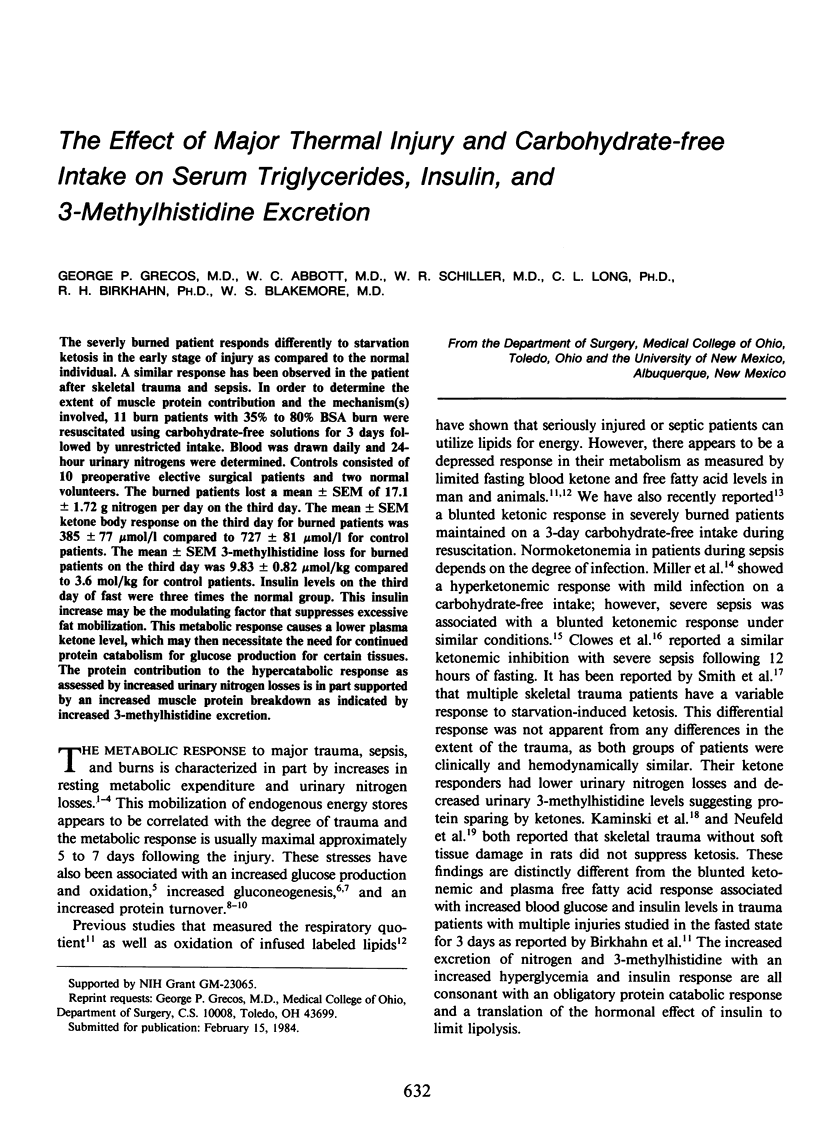
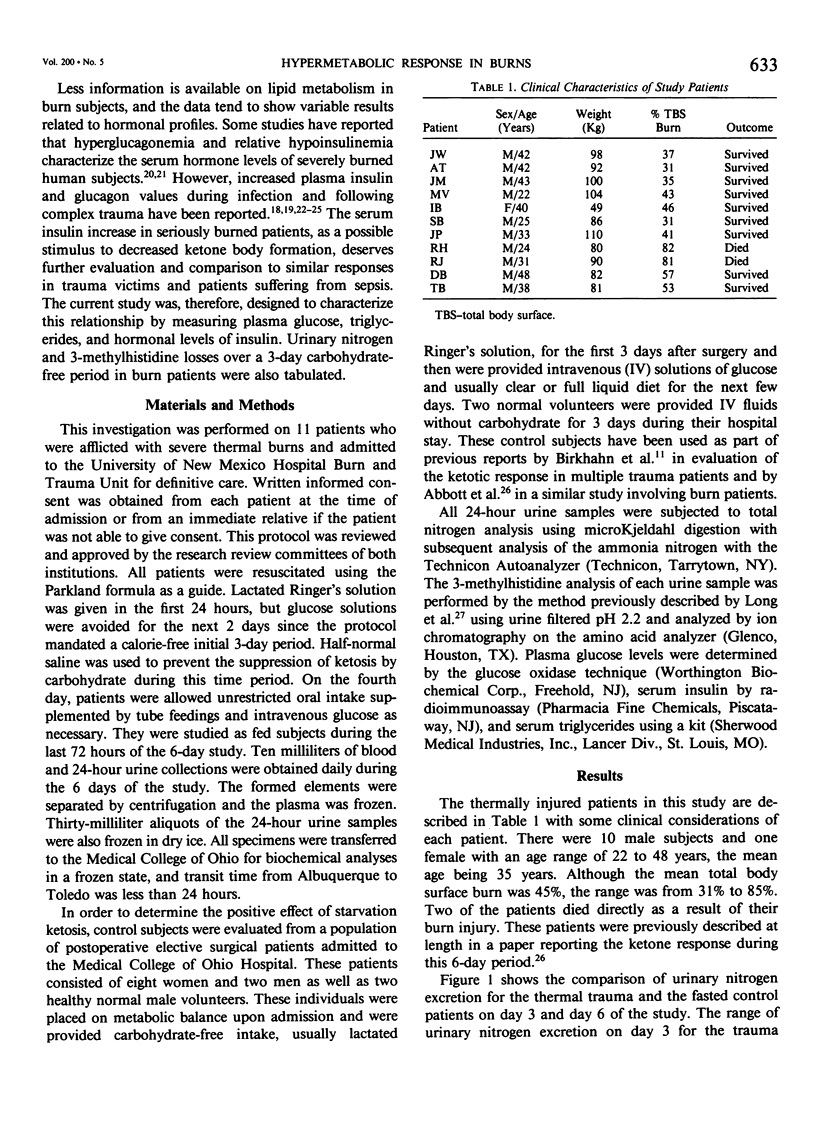
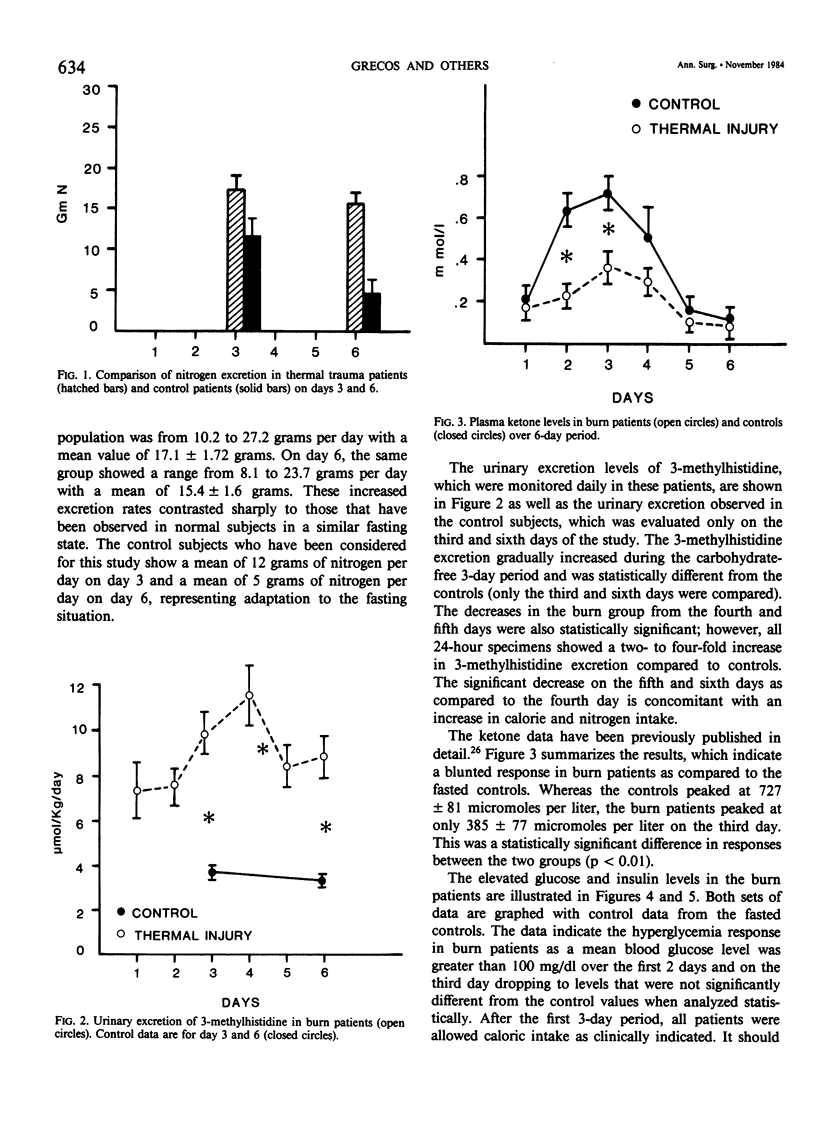
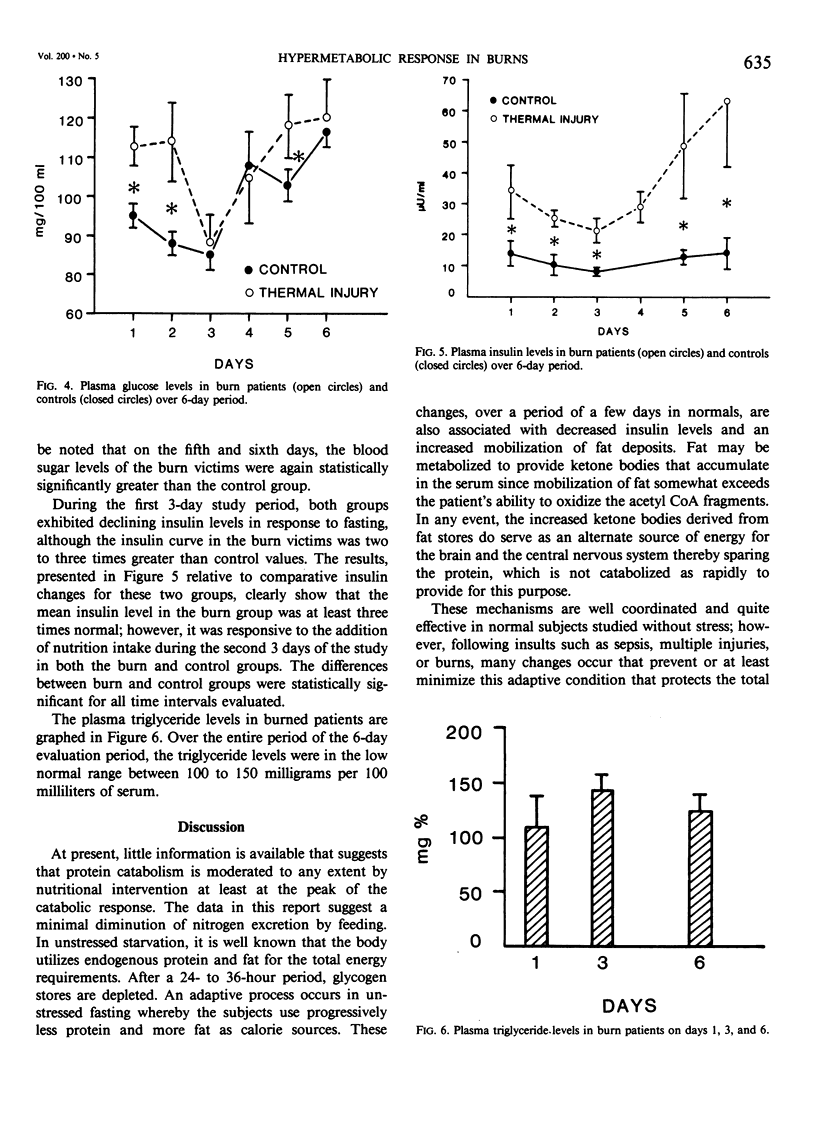
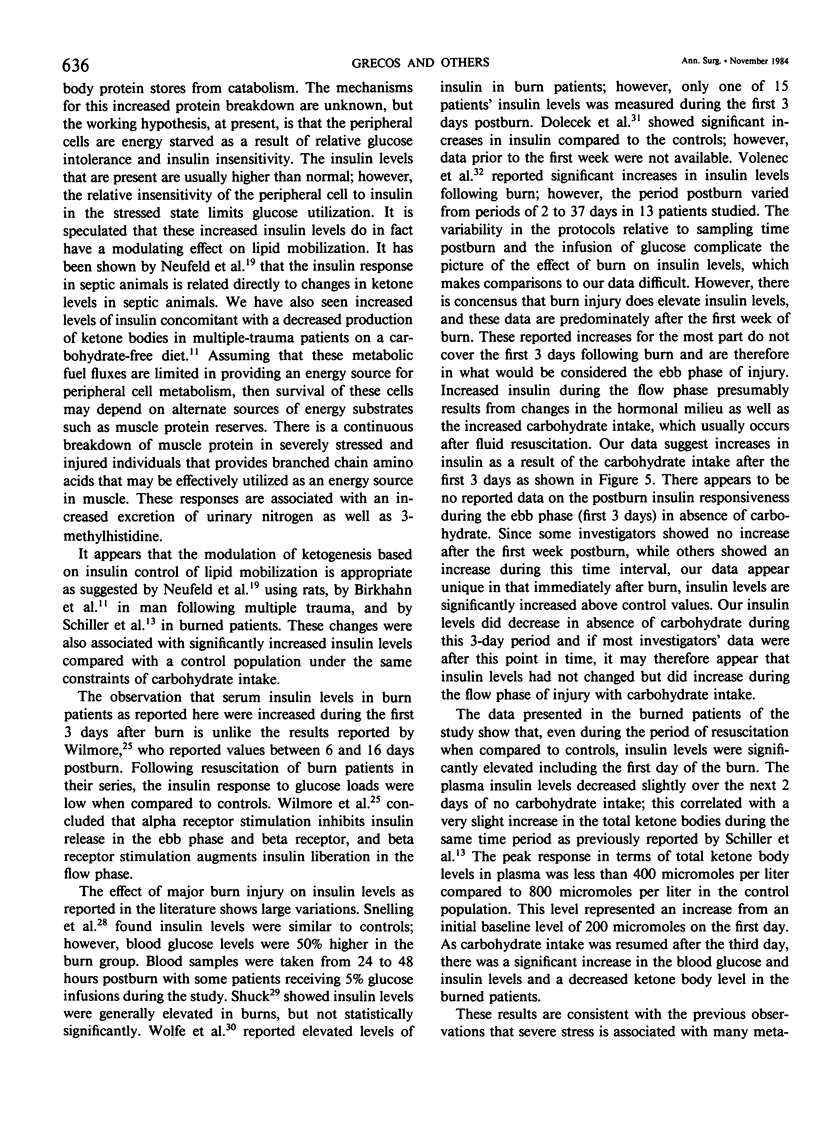
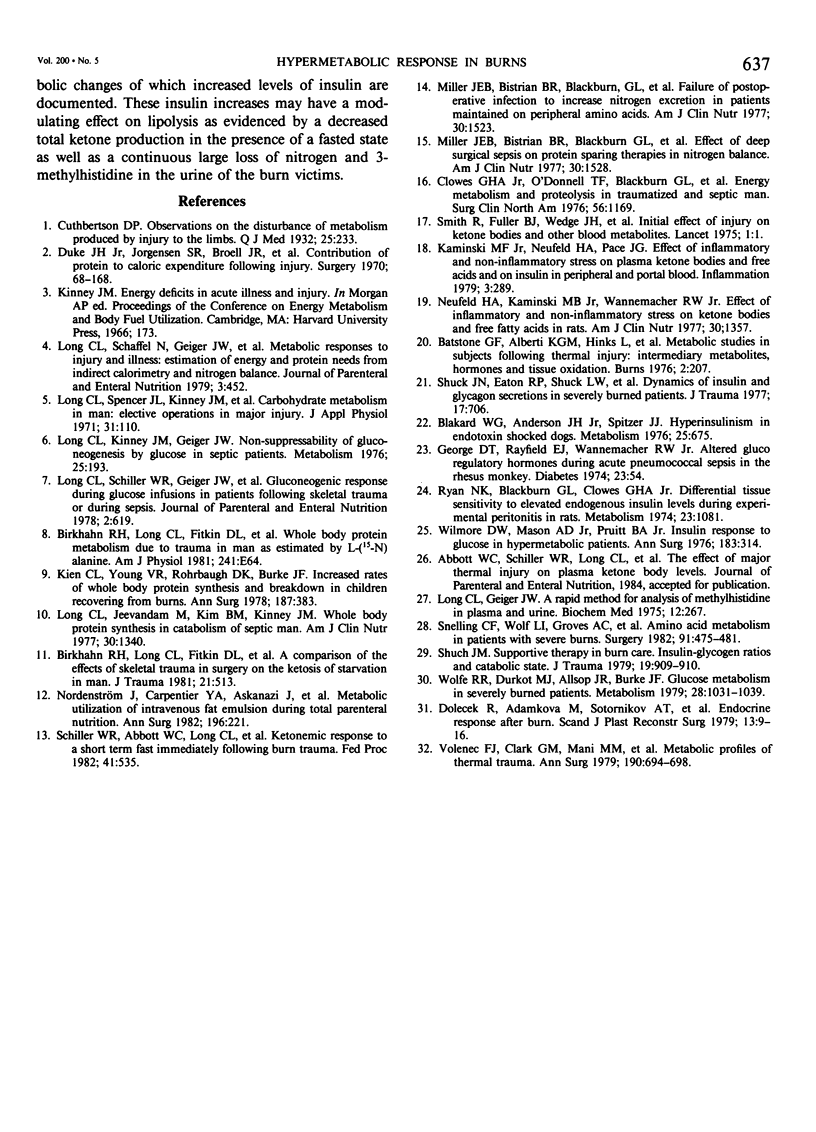
Selected References
These references are in PubMed. This may not be the complete list of references from this article.
- Birkhahn R. H., Long C. L., Fitkin D. L., Busnardo A. C., Geiger J. W., Blakemore W. S. A comparison of the effects of skeletal trauma and surgery on the ketosis of starvation in man. J Trauma. 1981 Jul;21(7):513–519. doi: 10.1097/00005373-198107000-00002. [DOI] [PubMed] [Google Scholar]
- Birkhahn R. H., Long C. L., Fitkin D., Jeevanandam M., Blakemore W. S. Whole-body protein metabolism due to trauma in man as estimated by L-[15N]alanine. Am J Physiol. 1981 Jul;241(1):E64–E71. doi: 10.1152/ajpendo.1981.241.1.E64. [DOI] [PubMed] [Google Scholar]
- Blackard W. G., Anderson J. H., Jr, Spitzer J. J. Hyperinsulinism in endotoxin shock dogs. Metabolism. 1976 Jun;25(6):675–684. doi: 10.1016/0026-0495(76)90065-2. [DOI] [PubMed] [Google Scholar]
- Clowes G. H., Jr, O'Donnell T. F., Blackburn G. L., Maki T. N. Energy metabolism and proteolysis in traumatized and septic man. Surg Clin North Am. 1976 Oct;56(5):1169–1184. doi: 10.1016/s0039-6109(16)41036-4. [DOI] [PubMed] [Google Scholar]
- Dolecek R., Adámková M., Sotorníková T., Závada M., Kracmar P. Endocrine response after burn. Scand J Plast Reconstr Surg. 1979;13(1):9–16. doi: 10.3109/02844317909013013. [DOI] [PubMed] [Google Scholar]
- Duke J. H., Jr, Jørgensen S. B., Broell J. R., Long C. L., Kinney J. M. Contribution of protein to caloric expenditure following injury. Surgery. 1970 Jul;68(1):168–174. [PubMed] [Google Scholar]
- Kaminski M. V., Jr, Neufeld H. A., Pace J. G. Effect of inflammatory and noninflammatory stress on plasma ketone bodies and free fatty acids and on glucagon and insulin in peripheral and portal blood. Inflammation. 1979 Jul;3(3):289–294. doi: 10.1007/BF00914186. [DOI] [PubMed] [Google Scholar]
- Kien C. L., Young V. R., Rohrbaugh D. K., Burke J. F. Increased rates of whole body protein synthesis and breakdown in children recovering from burns. Ann Surg. 1978 Apr;187(4):383–391. doi: 10.1097/00000658-197804000-00007. [DOI] [PMC free article] [PubMed] [Google Scholar]
- Long C. L., Geiger J. W. A rapid ion exchange method for quantitation of the urinary excretion of 3-methylhistidine. Biochem Med. 1975 Mar;12(3):267–273. doi: 10.1016/0006-2944(75)90128-3. [DOI] [PubMed] [Google Scholar]
- Long C. L., Jeevanandam M., Kim B. M., Kinney J. M. Whole body protein synthesis and catabolism in septic man. Am J Clin Nutr. 1977 Aug;30(8):1340–1344. doi: 10.1093/ajcn/30.8.1340. [DOI] [PubMed] [Google Scholar]
- Long C. L., Kinney J. M., Geiger J. W. Nonsuppressability of gluconeogenesis by glucose in septic patients. Metabolism. 1976 Feb;25(2):193–201. doi: 10.1016/0026-0495(76)90049-4. [DOI] [PubMed] [Google Scholar]
- Long C. L., Schaffel N., Geiger J. W., Schiller W. R., Blakemore W. S. Metabolic response to injury and illness: estimation of energy and protein needs from indirect calorimetry and nitrogen balance. JPEN J Parenter Enteral Nutr. 1979 Nov-Dec;3(6):452–456. doi: 10.1177/014860717900300609. [DOI] [PubMed] [Google Scholar]
- Long C. L., Schiller W. R., Geiger J. W., Blakemore W. S. Gluconeogenic response during glucose infusions in patients following skeletal trauma or during sepsis. JPEN J Parenter Enteral Nutr. 1978 Nov;2(5):619–626. doi: 10.1177/014860717800200501. [DOI] [PubMed] [Google Scholar]
- Long C. L., Spencer J. L., Kinney J. M., Geiger J. W. Carbohydrate metabolism in man: effect of elective operations and major injury. J Appl Physiol. 1971 Jul;31(1):110–116. doi: 10.1152/jappl.1971.31.1.110. [DOI] [PubMed] [Google Scholar]
- Miller J. D., Bistrian B. R., Blackburn G. L., Flatt J. P., Rienhoff H., Trerice M. Failure of postoperative infection to increase nitrogen excretion in patients maintained on peripheral amono acids. Am J Clin Nutr. 1977 Sep;30(9):1523–1527. doi: 10.1093/ajcn/30.9.1523. [DOI] [PubMed] [Google Scholar]
- Miller J. D., Blackburn G. L., Bistrian B. R., Rienhoff H. Y., Trerice M. Effect of deep surgical sepsis on protein-sparing therapies and nitrogen balance. Am J Clin Nutr. 1977 Sep;30(9):1528–1532. doi: 10.1093/ajcn/30.9.1528. [DOI] [PubMed] [Google Scholar]
- Neufeld H. A., Kaminski M. V., Jr, Wannemacher R. W., Jr Effect of inflammatory and noninflammatory stress on ketone bodies and free fatty acids in rats. Am J Clin Nutr. 1977 Aug;30(8):1357–1358. doi: 10.1093/ajcn/30.8.1357. [DOI] [PubMed] [Google Scholar]
- Nordenström J., Carpentier Y. A., Askanazi J., Robin A. P., Elwyn D. H., Hensle T. W., Kinney J. M. Metabolic utilization of intravenous fat emulsion during total parenteral nutrition. Ann Surg. 1982 Aug;196(2):221–231. doi: 10.1097/00000658-198208000-00016. [DOI] [PMC free article] [PubMed] [Google Scholar]
- Ryan N. T., Blackburn G. L., Clowes H. A., Jr Differential tissue sensitivity to elevated endogenous insulin levels during experimental peritonitis in rats. Metabolism. 1974 Nov;23(11):1081–1089. doi: 10.1016/0026-0495(74)90075-4. [DOI] [PubMed] [Google Scholar]
- Shuck J. M., Eaton P., Shuck L. W., Wachtel T. L., Schade D. S. Dynamics of insulin and glucagon secretions in severely burned patients. J Trauma. 1977 Sep;17(9):706–713. doi: 10.1097/00005373-197709000-00007. [DOI] [PubMed] [Google Scholar]
- Shuck J. M. Supportive therapy in burn care. Insulin-glucagon ratios and catabolic state. J Trauma. 1979 Nov;19(11 Suppl):909–910. [PubMed] [Google Scholar]
- Smith R., Fuller D. J., Wedge J. H., Williamson D. H., Alberti K. G. Initial effect of injury on ketone bodies and other blood metabolites. Lancet. 1975 Jan 4;1(7897):1–3. doi: 10.1016/s0140-6736(75)92369-7. [DOI] [PubMed] [Google Scholar]
- Snelling C. F., Woolf L. I., Groves A. C., Moore J. P., Duff J. H. Amino acid metabolism in patients with severe burns. Surgery. 1982 Apr;91(4):474–481. [PubMed] [Google Scholar]
- Volenec F. J., Clark G. M., Mani M. M., Kyner J., Humphrey L. J. Metabolic profiles of thermal trauma. Ann Surg. 1979 Dec;190(6):694–698. doi: 10.1097/00000658-197912000-00004. [DOI] [PMC free article] [PubMed] [Google Scholar]
- Wilmore D. W., Mason A. D., Jr, Pruitt B. A., Jr Insulin response to glucose in hypermetabolic burn patients. Ann Surg. 1976 Mar;183(3):314–320. doi: 10.1097/00000658-197603000-00018. [DOI] [PMC free article] [PubMed] [Google Scholar]
- Wolfe R. R., Durkot M. J., Allsop J. R., Burke J. F. Glucose metabolism in severely burned patients. Metabolism. 1979 Oct;28(10):1031–1039. doi: 10.1016/0026-0495(79)90007-6. [DOI] [PubMed] [Google Scholar]


